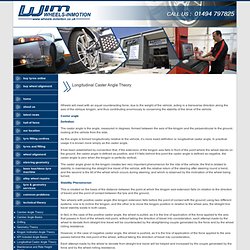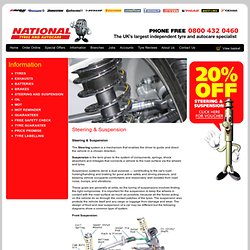

Steering gear box. Power Steering Animation. Caster angle. Car Tyres Fitting and Wheel Alignment Specialists. Wheels will meet with an equal counteracting force, due to the weight of the vehicle, acting in a transverse direction along the axis of the oblique kingpin, and thus contributing enormously to conserving the stability of the drive of the vehicle.

Castor angle Definition The castor angle is the angle, measured in degrees, formed between the axis of the kingpin and the perpendicular to the ground, looking at the vehicle from the side, As this angle is formed longitudinally relative to the vehicle, it’s more exact definition is: longitudinal castor angle, In practical usage it is known more simply as the castor angle, It has been established by convention that, if the extension of the kingpin axis falls in front of the point where the wheel stands on the ground, the castor angle is defined as positive, and if it falls behind this point the castor angle is defined as negative, the castor angle is zero when the kingpin is perfectly vertical, Stability Phenomenon Tilt State Phenomena. Caster - Explained. Track rod end/Steering arm. How To Install Replace Steering Outer Tie Rod End Ford Taurus Mercury Sable 96-06 1AAuto.com.
What Is a Steering Arm? Camber angle. Car Tyres Fitting and Wheel Alignment Specialists. Today this angle is properly the most common to be misdiagnosed as tracking wear.

The principle of the angle is to distribute the cars weight evenly across the width of the tyre thus maximising grip, but this angle demands the most complicated amount of maths of all the angles. As the pictures suggest, if the camber is considered negative then it will lean in toward the cars centre line relative to the vertical, and the opposite will be found for positive, the main problem with camber is it has an active range which is expressed by the suspension, example being if the front camber setting is 30 min negative in a relaxed condition then it will progress to 60 min when hitting a bump (loaded) and drop to zero min off the bump (unloaded) this is fine but all those bumps and pot holes over the years may have moved, bent or compressed the cars camber beyond the relaxed 30 min, now loaded or unloaded the angle is dynamically out of range. Strut Suspension Camber Behavior. Shock absorber. National Tyres and Autocare - Shock Absorbers.
The Steering system is a mechanism that enables the driver to guide and direct the vehicle in a chosen direction.

Suspension is the term given to the system of components, springs, shock absorbers and linkages that connects a vehicle to the road surface via the wheels and tyres. Suspension systems serve a dual purpose — contributing to the car's road holding/handling and braking for good active safety and driving pleasure, and keeping vehicle occupants comfortable and reasonably well isolated from road noise, bumps, and vibrations.
These goals are generally at odds, so the tuning of suspensions involves finding the right compromise. It is important for the suspension to keep the wheels in contact with the road surface as much as possible, because all the forces acting on the vehicle do so through the contact patches of the tyres. The suspension also protects the vehicle itself and any cargo or luggage from damage and wear. Front Suspension: CV Boot Rear Suspension: How it Works Suspension Arm. Torsion Bar. Torsion Bar. Basic Suspension System. Understanding a Suspension System. Leaf Spring. Leaf Spring. Independent Suspension. Independent Suspension. Steering column. Corsa steering column.